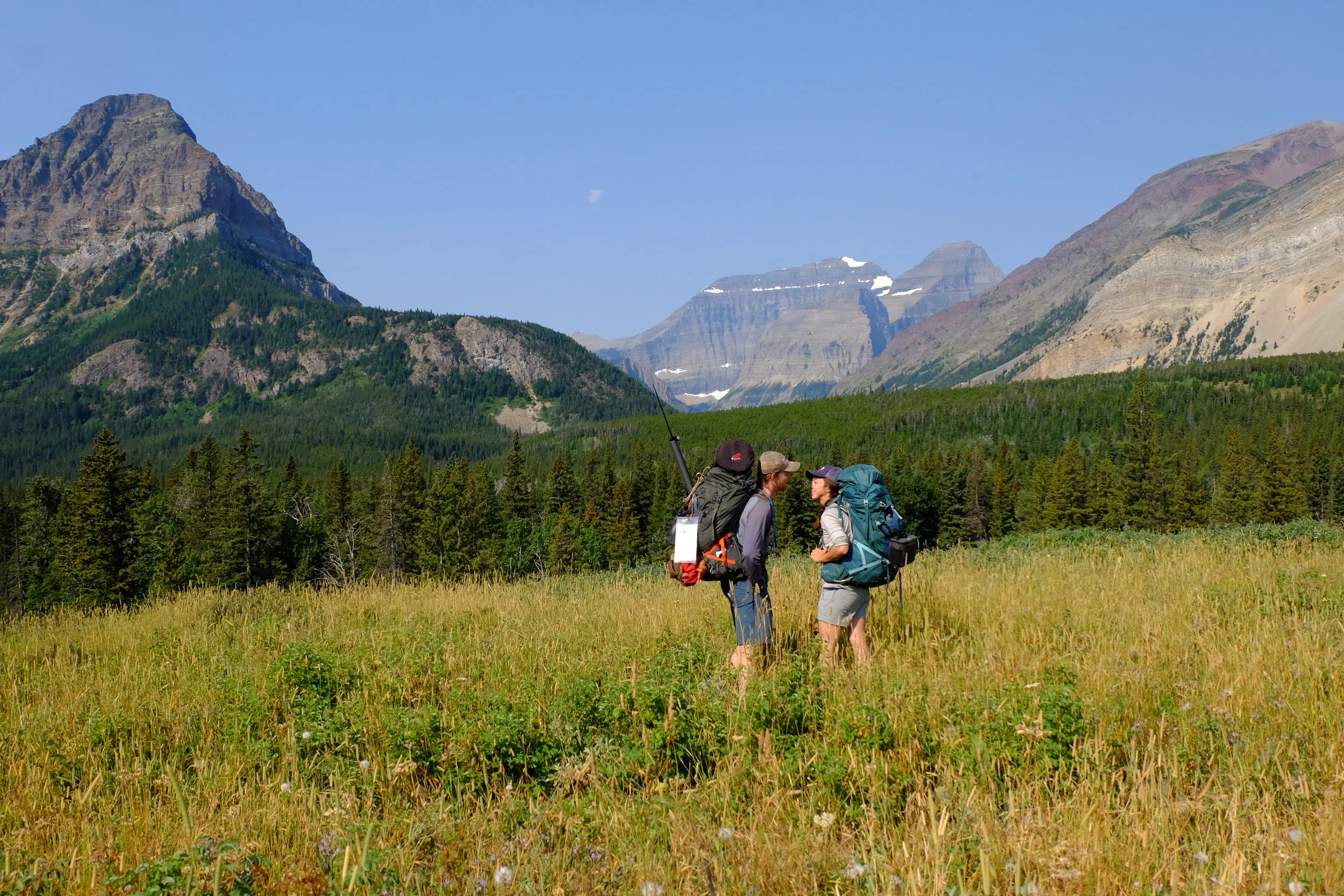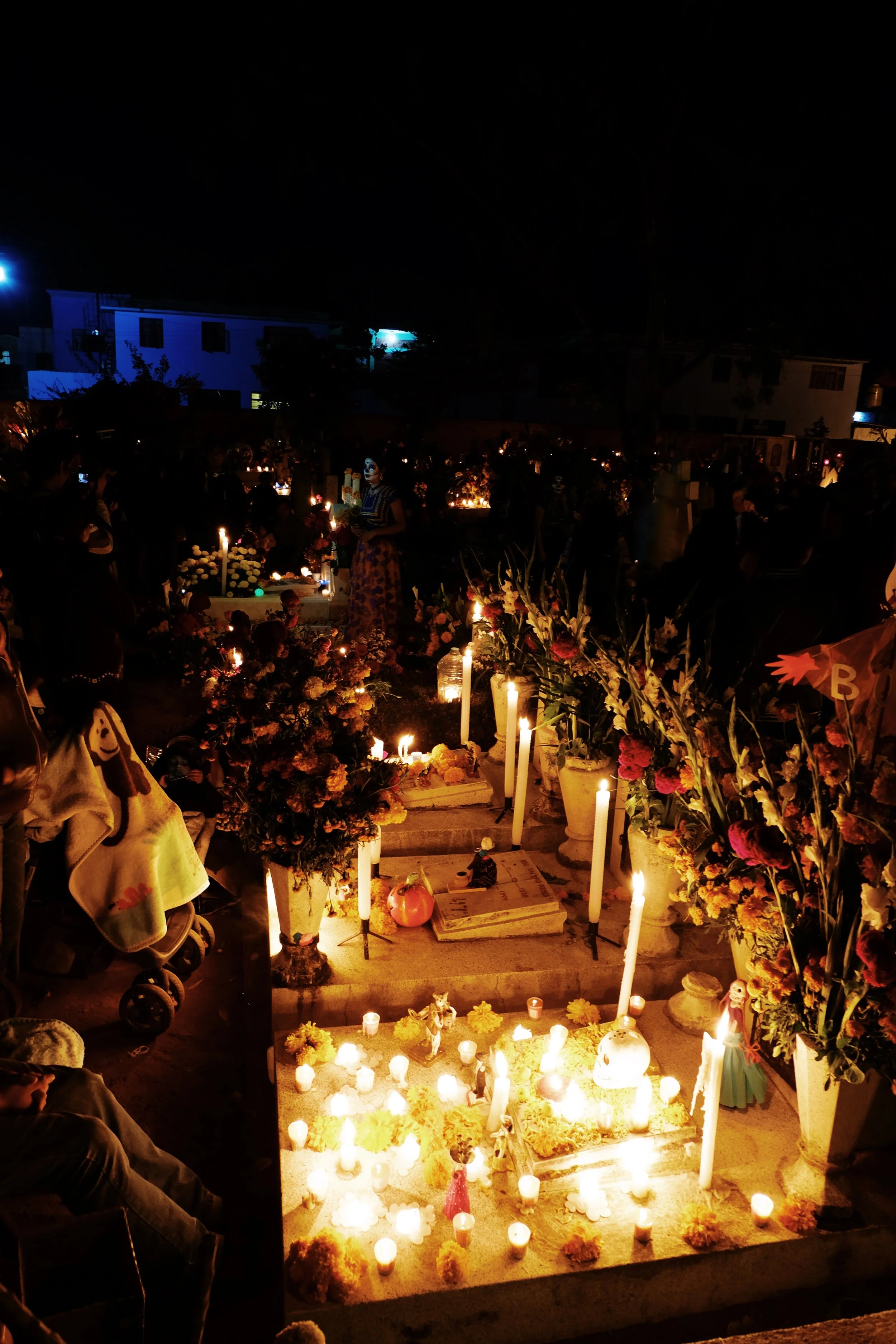Glacier National Park
"Take back the weed, take back the cocaine, baby...don't need it now your love was all I was after." These words of Willie and Waylon whipped out the windows while west of Whitefish. During the drive north from Missoula, Sara compiled a few playlists for the upcoming hike in Glacier National Park; the first song to stick started with those words and were soon followed by ballads composed by Johnny Paycheck, Glenn Campbell, and Jim Croce. I was certain the score would suit us for at least four days - enough to cover our upcoming four day hike in Glacier. We planned a stop in Whitefish before heading to our campsite just outside of the West Glacier entrance, intent on trying some local brew.
Blue skies and golden grass along the Belly River
Sara found a place on Yelp named Bonsai Brewery reputed for their unique venue and vibe. The experience didn't disappoint. Built in an old, one story, ranch style home with a large backyard shaded by giant firs, blooming deciduous, and Coca-cola umbrellas. The seating out back was casual, comfortable and filled with the smell of grilled kabobs and burgers: a homey, at-ease atmosphere oft dreamed, rarely found. Dogs wandered throughout and their owners had fresh, cold beer in hand. Inside reminded me of my aunt's house, in a good way, with a large horseshoe bar built in the kitchen and dining room. Tables and chairs filled gaps between the unique, eclectic decor - snake plants, speckled paint, Christmas lights. Eighties classics reverberated across the chalk boards advertising beer options and the refreshing air conditioning carried the waves throughout the brewery. I ordered a Belgian Dubbel and we went outside back into the blistering, ninety-degree Montana summer: this time, cold beers in hand. The sun warmed my face, arms, and legs while the beer cooled everything to a perfect temperature reminding me of the comfort found in hot springs near cold rivers. We enjoyed the free wi-fi, finished our beer, and drove to our free campsite on the western shore of the North Fork of the Flathead River.
We didn't start the hike until August 4th which gave us a full day to recover from our West Glacier Ranger Station experience: warning, walk-in permits at Glacier in August are an elusive beast. Expect to wait in line for a while or sleep out front. It's worth the wait, but make sure to have a few back-up itineraries planned in case you don’t secure your first choice.
Views from the foot of Cosley Lake
Our hike started at the furthest northern entrance of Glacier called Chief Mountain; you can see the Canadian border from the parking lot. While we prepared our packs at the trailhead, a group of college-aged girls did their own version of the same thing. Little did we know, after our initial day of hiking, we had the same itinerary as them. The first day, by no means disastrous, wore us out. Six miles along the Belly River and exposed to the hot summer sun and smoke from distant forest fires required constant hydration and took a toll on my pale skin. Additionally, being our first four day trip, our packs were heavier than usual and required some cross-loading during the six miles. We arrived to Gable, our first campsite, in the late afternoon. Overall, the first day was a learning experience but built our confidence in grizzly bear country.
The college girls, on the other hand, showed up to Gable around nine in the evening: dehydrated, lost, and humbled. Their planned route from the Chief Mountain trailhead to Slide Lake campground along Lee Ridge consisted of overland travel marked by stacked rocks called Cairns. Their only map in hand was the basic overview map provided by the Park Rangers at the entrance, adding to the complexity of their route. With primitive trail and map guidance, they missed the turn to Slide Lake and fortunately ran into a Park Ranger at the Gable Ranger Station, four miles or so off course. After a lecture from the Park Ranger, they entered the Gable campground and our lives for the remainder of our time in Glacier.
Sara along the shore of Elizabeth Lake
After providing them with some crucial water and listening to their story, we realized that we had identical itineraries: Gable, Cosley Lake, and the foot of Elizabeth Lake. After 15 minutes of conversation their hunger started to talk and they began preparing dinner. As if Murphy himself came down to remind us all of his law, their stove stopped working. It couldn't have gotten any worse for these girls, and we all, themselves included, found comedy in their epic of misfortune. Their presence added an extra, human layer to our Glacier trip; we quickly found that the most satisfying parts of the American wilderness were solitude and social interactions. The two sustained independent joy but together served as catalysts for both commune and community. The solitude greased social interactions like beer in a tavern. The structure of Glacier's backcountry camping system added to this high quality of social exchange: campgrounds had communal cooking and cleaning areas, forcing hikers to interact with each other at meal times. Although this is primarily intended to reduce grizzly bear interactions, I think it serves as an excellent social stimulant.
Fly fishing on Cosley Lake
The following two days clouds fought for control of the skies. Our hikes were short leaving ample time for napping, listening to Stephen King's It, and fly fishing. My friend Paul had given me some fly fishing equipment a few weeks before and I spent most of my spare time developing that technique. The fishing on Cosley Lake proved challenging due to consistently windy conditions; several fish rose for my dry fly but missed. I blamed the wind, but in reality my technique deserved most of the criticism. Despite a slow and partially unsuccessful day of fishing, the views leading to Stoney Indian Pass dominated the horizon, the valley climbing in steps westward towards the end. On the northern side, closer to the Canadian border, a waterfall cascaded down three significant steps framed within a cirque of grassy alpine meadows where grizzlies roam. When the sunlight peaked through the thick overcast, greens on the hillside glowed and the tiered waters shined brilliantly but only for a moment until the next cloud rolled in. I didn't catch anything that day and in the evening we cooked dinner and chatted with our college grad friends and some new people from California who hiked 14 miles that day over Swiftcurrrent Pass and down some 3000 feet to Cosley Lake. They were hiking the Northern Circle - an amazing hike which usually requires at least one brutal day if you have a constrained timeline.
The next morning we walked to Elizabeth Lake and ate wild berries throughout the entire hike. They looked like raspberries - probably my favorite berry - but tasted sweeter and creamier like a strawberry, and depending on ripeness, could taste creamy as ice cream or more tart like a commercial raspberry. We frequently stopped to sample the local terroir, consequently, slowing progress. The campsite at Elizabeth Lake was full, and walking in we were greeted by ten fellow campers, our newly minted college graduate friends included. I began setting up my fly rod determined to catch at least one fish in the Glacier backcountry. Walking south along the western shore of Elizabeth Lake - Sara accompanying me with a camera, chair and book - we passed two other fisherman pulling in some Rainbow Trout. I quickly fished inlets as we walked. Soon we came across a significant inlet, large enough to be a separate body and protected from the growing wind. I noticed several trees in the water and shallow points providing potential shelter for trout. I cast my line, caught on some brush, made some knots, fixed my mistakes, and eventually got a fly onto the surface of the water. Most of your time as a novice fly fisherman is spent fighting yourself and the surrounding environment seeming to conspire against your every cast. Despite my beginner status, I found a few angles providing ample space to my rear for casting. These adjustments yielded three 12 inch Rainbows.
The evening sky continued to open up, and the sun dipped behind the mountain ridge to our west along Elizabeth lake, lighting up the eastern ridge with red and orange brush strokes. Back at camp I told my fish stories and we made our famous Asian Pasta from the NOLs Wilderness Cookbook while all the other campers watched enviously from the wet openings of their Mountain House freeze dried food packages. We ended up sharing some of our leftovers with the college grads, who, Sara had informed me, were Mennonites. I went back out to do some late evening fishing as the twilight vanished. The progression of that evening stamped itself upon my memory. Having caught fish the pressure was off, and I silently cast: the whish of rod, line, and fly the only sound accompanying an occasional rising trout. I saw the stages of evening mature into night and I ignored my screaming feet for the sake of Glacier's evening aesthetics until it became too cold to stand in the icy water any longer.
Moonlight on Elizabeth Lake
Leaving that moment and the wilderness facilitating it was difficult. However, the final morning bottomed out when our stove stopped working immediately after the college graduates shared some fuel with us as repayment for letting them borrow our stove the first night at Gable. Sara and I ate granola bars and mentally prepared for the endless supply of burgers and beer that awaited back in civilization. I wasn't even mad about the stove; it only added to our story.








